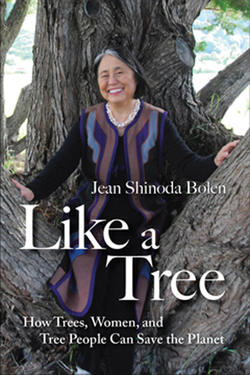Читать книгу Like a Tree - Jean Shinoda Bolen - Страница 19
На сайте Литреса книга снята с продажи.
Tree Anatomy and Physiology
ОглавлениеWhat are tree rings, anyway? The question led me to learn about the nutrient transport system inside of trees. Water travels upward through the trunk from its underground roots. A large root called the taproot grows straight down, other roots grow out laterally and branch out to hold the tree down, while very fine root hairs at the ends of roots take water and dissolved minerals and salts from the soil. If we could see this branching root system, it might resemble the structure and size of tree branches that we can see growing up from the trunk (as above, so below). Inside the roots, the tree changes the water into a liquid called root sap, which moves up the trunk in a layer of wood called the sapwood or xylem, comprising masses of miniscule tubes. Inside the xylem, root sap moves through the branches and out to nourish every leaf. Each green leaf is a little photosynthesis unit, which uses moisture and sunlight to remove carbon from the carbon dioxide in the air from which it makes sugars to feed the tree and oxygen to release into the air.
These sugars are then carried through strings of cells out from the leaves, outward and downward, to nourish the rest of the tree. These cells form a layer on the outside of the xylem, just beneath the bark of the tree, called the phloem. In between the xylem and the phloem, there is a thin layer of stem cell tissue, the cambrium, which runs from the leaves to the roots. All along the trunk there are medullary rays or conduits that link these elements with the outside of the tree, enabling the trunk of the tree to grow in diameter as the tree grows. The job of the cambrium is to create more xylem vessels on the inside and more phloem tissue on the outside. As xylem and phloem layers cease functioning and die, dead xylem becomes the heartwood, new xylem the sapwood, while the dead phloem is incorporated into the bark. Usually, new xylem is laid down in the spring and is wide and thin-walled; in the summer, the xylem is narrower, thick-walled, and dark in comparison with the spring xylem. These differences result in one growth ring per season. Having the cambrium close to the bark, the trunk of a tree can grow thicker year by year, some even for thousands of years.
My premed courses in college, medical school, internship, and residency were years of intense learning. There is an immense amount of information that a doctor of medicine needs to learn, and upon which we were tested, over and over again, with class rankings and the next rung up the professional ladder dependent on how much and how well we learned. Left out was the wonder of how the body was constructed and worked, or how the meeting of an ovum and sperm came with elaborate guidance on how to grow into a baby, or how a baby grows smoothly into an adult human being. There are glimpses of wonder along the way in the training of a doctor, but no one talked about such things. Wonder is all too often left behind in the process of becoming an adult, as well. When it is, an essential spiritual element is missing. We humans come into the world with a sense of wonder, expressed and seen most clearly in childhood. Wonder is a precious sensibility to retain. Wonder and imaginative play go together in childhood and are together in the mind of creative adults who can be fascinated and enthralled by their new discoveries that then stimulate ideas and art. Wonder makes living on this planet an adventure. Then as we become aware of the vulnerability of life, some are called to save lives, others to preserve nature.
To grow like a tree is to be part of an interconnected mutually supportive circle of life: from soil to tree to water vapor to clouds to rain to soil and up again (the big picture) as well as a mini-ecosystem that sustains and nourishes this one tree. Whether as one tree on a hillside or one tree among millions in a boreal rain forest, this is so for every tree that lives naturally.
To spread the ashes of a loved one in the forest or woods, or under a special tree, or plant a tree in memory of that person is a ritual link to this large circle of life and also an actual link when ashes are spread or remains are buried: ashes to ashes, dust to dust, and dust to soil. The Earth prevails. What is left of our once-embodied selves, in turn and in time, will be incorporated into the planet. The fern forests and the trees gave us oxygen and nutrients to grow from a single cell into a human being, which we recapitulate in the uterus. Everything on Earth began with her, grew out of her, and will return to her. This is Mother Earth as womb and tomb, personified as the Great Mother of ancient and indigenous peoples: Our Mother who art the Earth.
